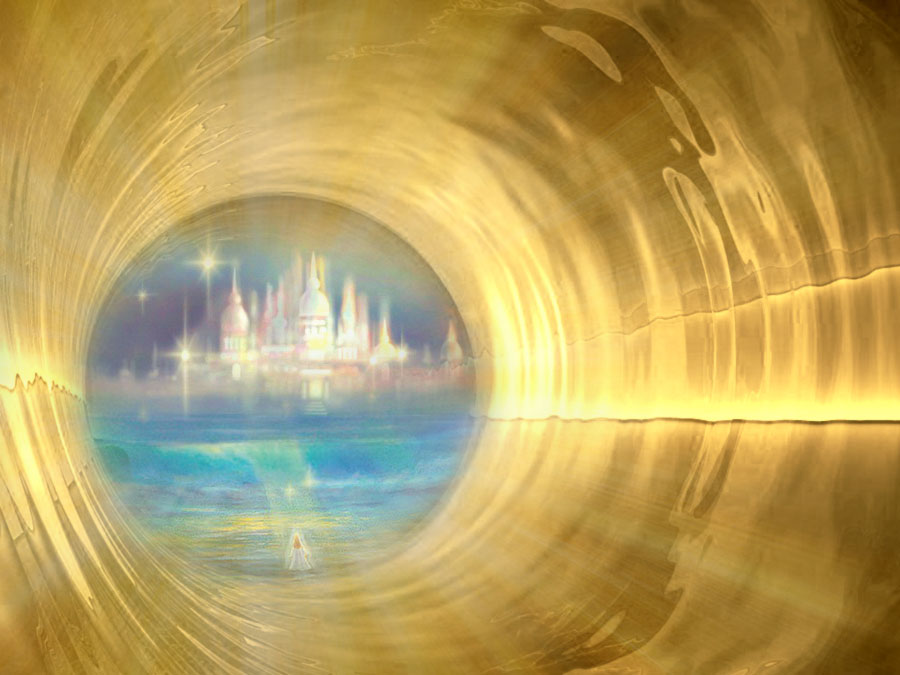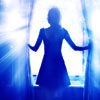Life In The Afterlife ~ Part II
 by Stafford Betty
by Stafford Betty
Never have we read such a spontaneous, simple, direct, happy and instructive series of scripts from ‘the other side’. – Science of Thought Review
In December 1965, a month after her death, Frances Banks, an Anglican nun for 25 years, found a ‘pure, unobstructed channel’ through which to describe the bracing new world she found herself in. The ‘channel’ was the mind of her close friend Helen Greaves. Greaves tells us what it felt like when Frances came through: ‘Gently, imperceptibly, I became aware of Frances. She was influencing my mind and, quite distinctly, I “registered” the thoughts she was conveying to me. Indeed, as soon as I let myself “listen” the thoughts formed into words and without a moment’s hesitation I reached for my pen.’
Thus was born Testimony of Light, a this-world/next-world collaboration between two highly respected elderly Englishwomen. In a preface to the book, Anglican Canon J. D. Pearce-Higgins ranks Testimony of Light with Mother Julian of Norwich’s Christian classic Revelation of Divine Love. I agree with the ranking, but the comparison is in other respects misleading. Testimony is not a book from medieval Europe (like Revelation), and many a Christian would find Testimony heretical in several places. On the other hand, the spiritual and moral life urged on the reader (in Testimony) is entirely consistent with the gospel of love and forgiveness preached by Jesus – or indeed by the saints and sages of the world’s major religions.
Without further ado, let’s dive in.
Upon ‘coming over’, Frances finds herself in a ‘kind of rest home’ run by the nuns of her order. “I am now lying in a bed, high up on a terrace, that looks over a vast sunlit plain. It is a beautiful scene, and so restful. … I am recuperating from the illness [cancer] which brought disintegration to my physical body.”
A few days later she was attracted to Exeter Cathedral where a memorial service for her was underway. This was her first descent, or visit, to earth following her death. Communicating through Greaves, she wrote, “I longed to materialize before you to show there is no death; but that was beyond my power to do.”
She apparently underestimated her abilities, for several in the small crowd later testified they saw her ghost dressed in the nun’s habit she wore while incarnate. A powerful personality in life – her friends said she had a ‘will of iron’ and was ‘fearless and outspoken’ – the intensity of her spirit seemed to break through the veil dividing the worlds.
Frances quickly recuperated and was up and about. She tells us: “I am now occupying a ‘cottage’ of my own … with a very pretty garden … bright with golden flowers.”
It isn’t long before she draws conclusions about her strange, yet familiar, new world: “I kept assuring myself in wonder, ‘I have made The Change!’ I realized then that I could both see and hear as before, only now in a more intense way.”
She elaborates: “’So this is death!’ I recall saying to one of the Sisters who was beside me – ‘Life separated by density – that is all!’”
One of her earliest experiences is also one of the most fascinating. Many of us were taught as children to think of Judgment Day as a frightening ordeal. There we are, worried and skulking, bent low before the God of the Universe who, sitting on a throne surrounded by angels, is preparing to judge us and send us to heaven, hell, or purgatory. But that’s not at all the way it is, says Frances:
“Somewhere in the deeps of my mind two ‘blueprints’ are brought forward into my consciousness. These are so clear that I can (literally) take them out, materialize them and study them. One is the Perfect Idea with which my spirit went bravely into incarnation. The other is the resultant of only a partially-understood Plan … in fact my life as it was actually lived. … First of all the mind looks at the whole comparison, and sets the blueprints side by side. This is the first shock; a true humbling of yourself to find that you did so little when you would have done so much; that you went wrong so often when you were sure that you were right. During this experience the whole cycle of your life-term unfolds before you in a kaleidoscopic series of pictures. During the crisis one seems to be entirely alone. Yours is the judgment. You stand at your own bar of judgment. You make your own decisions. You take your own blame. … You are the accused, the judge and the jury.”
Judgment – the logic behind it, the way it plays out in individual cases – is the leading theme of this research. Its midsection focuses on sixteen spirits Frances met. She tells us about their lives, then shows us what awaits them in the afterlife. We are introduced to a Nazi leader “lodged in the shadows” for 20 years since his suicide in 1945, and a young Jewish mother “bound to him by her deep hatred”. The Shadowlands are of special interest to Frances. She tells us there are “hells of the spirit and the mind, confining states of misery; dark, depressing and as real as the tortured consciousness of the dweller therein makes them. … [They contain] squalid dwellings inhabited by unhappy, tormented beings who jeer and mock and pursue their warped existences.”
At one point she, along with three of her fellow nuns and several protective guardian spirits, entered one of these regions and talked at length with a French painter “reduced to the gutter” shortly before his violent death. There he was, painting. His smelly hovel was stacked with paintings: “They were all the same; all dark, all hideous, all primitive and almost evil in their sardonically clever interpretation of character and all exceedingly ugly. But there was one strange feature common to all of them. A door … its dark panels closing away a suggestion of light.” She talks to him:
“’You’re making your own hell, you know.’
He swept out his arm in an eloquent gesture. ‘I never made this.’
‘Not actually, only by your thoughts you have … just as the others done.’
‘The others here? … Haven’t an idea in their heads. They don’t even know the differences between light and shade. …’
‘And do you?’ I pointed deliberately to the masses of dingy color in his picture.
His temper rose at once.
‘Yes, I do!’ he roared. He stalked across the room, back to his easel, glared at the half-finished canvas on it. ‘Damn your eyes. I could paint once. I did paint I tell you, really paint. …’
‘But not now?’
Suddenly he was quiet, anger spent. ‘Could you paint here?’ he whispered.”
The conversation continues until Frances, with assistance from one of her companions, convinces him to try introducing light into his pictures. Amazed at the turn of events, he allows himself to leave the dingy street he lives on and walk up “towards a hill where the gloom was threaded with a spear of brightness.” This story underscores the point that no one, however corrupt, is hopelessly lost, no one is condemned to hell forever. Frances tells us that missionary spirits routinely ply these dark spaces and invite “the stumblers” to turn their backs on their crimes and receive rehabilitation. The French painter is typical. He might not find comfort in the light the first time he’s led out of the murk, but the next time might be easier. No one, however, is ever forced. C.S. Lewis said that ‘the gates of hell are locked from the inside’. Strange to say, many are the spirits who, after a lifetime of evildoing, feel more at home inside the gate, inside their self-made hell, as far away from the Light as they can get. Frances tells us there are three conditions to be met before there can be progress: facing one’s defects, yearning to be free from those defects, and service to fellow spirits. Some want to change, some don’t. Just as on earth.
We’ve been looking at the dark side of the afterlife, but there is much more light than darkness in Frances’s book. One of the spirits she tells us about
“had been a nurse and missionary for many years of her life in Africa, and had lived the Christian religion. She was put to death when there had been a uprising by the natives, and with her, a small native boy whom she had befriended. They arrived here together, for it seemed that even in the period of transition to this plane she had held the child to her with love.”
This humble woman lacked a “well-developed intellect [but] radiated peace and love and joy; and death had meant little to her”. As a result, she was translated to her rightful place in one of the “Higher Spheres”.
Seventeen months after Frances’s death, Frances herself had made progress. Helen Greaves, the medium, reports having a vision of Francis, and this vision tells us as much about the world to come as Frances’s words. This is what Greaves saw:
“I had a distinct ‘vision’ of Frances. This was not the Frances I had known, nor was it the Spirit I had ‘seen’ clairvoyantly in her habit when she was present at her own Memorial Service. … This was a different Being, a Spirit filled with Light, radiant and glorious. … I distinctly recall that her robe impressed me. It was of a light soft blue and it sparkled and shone. … Her face was the face of a young woman. She looked breathtakingly beautiful.”
Stagnation in self-made hells of the Lower Astral; progress upward to a Higher Sphere where dwell great souls and teachers of wisdom – each of these destinies, one upward and the other downward, is self-made.
The most captivating segment of the book tells of a girl named Jeannie who wanted more than anything to become a dancer but contracted polio at the age of eight. After months in an iron lung, she came out with one leg shrunken and shorter than the other. When she died of pneumonia three years later, she woke up in the care of the sisters, Frances among them. Frances and Jeannie became fast friends.
Jeannie didn’t at first understand that she had died, so it was with speechless wonder that she saw her legs:
“She ran her hands her calves, over the ankles, fingering the bones of the feet carefully and then back to the knees. She did this over and over as if she couldn’t believe that which she could feel and see. She was silent, puzzled. It evidently never occurred to her to stand up. Habit was still too strong. She just sat there holding her legs and gazing down at her feet. Presently she looked up at us.
‘Is it a miracle?’ she asked in a awed voice.
It wasn’t long before Jeannie “ran from flowers to flowers; she skipped and sang and laughed for pure joy.”
One day Frances found her in a sober mood standing in her garden:
“’I’ve come to see you, Sister.’ There was a pause. Her eyes regarded me with direct candor. ‘I’ve just realized something.’
I waited.
‘I’ve realized that I’m not dreaming,’ she said quietly. ‘I’m dead.’ Her gaze held mine. ‘We’re all dead. That’s true, isn’t it?’
‘Yes. It’s true, Jeannie,’ I answered her, ‘but you see we’re really more alive than ever. You’ve only got rid of your sick old body and found a new one. …’
She accepted this.
‘I suppose this is …a sort of Heaven.’
‘It’s the beginning of Heaven, Jeannie.’
‘You mean we’re only starting? … We’re not there yet?’
‘Not in the Heaven you mean, Jeannie. But we’re on our way there.’
She digested this. ‘But it’s so beautiful here. Everyone’s so kind and … and … angelic.’
‘We’re certainly not angels,’ I retorted and we both laughed at that. She was quiet suddenly.
‘Then where’s God?’ she demanded.
‘Much too far away for us even to see Him. We’re not ready for His glory yet. But we’re all going forwards, on towards His Heaven. …’”
But not directly, as we shall see in a moment. There are dance festivals in the astral world, and Jeannie is looking forward to them. She hopes to perfect her skills with hard work at the Halls of Beauty:
“’Oh, it will be lovely! I’ll work so hard and I’ll be good. I do mean to be ready soon. Of course, I’ll miss you and Sister Hilda and Mother Florence and everybody, but I want to go so much. I must go soon. You see,’ she stopped dancing, quietened and stood still before me, ‘You see, I’ve got to be perfect at dancing before …’ she broke off.
‘Before what, dear?’
‘Before I go back to earth again … really to be a dancer.’
For a while I was silenced, overwhelmed by the wisdom of this child.”
So there it is: reincarnation. The subject is treated in depth on the last page of the scripts.
“So many units [souls] return again and again to the nothingness of dense matter [earth conditions], bravely asserting the lasting reality of their illumination. So often such units, clothed in their passing personalities, fall into ignorance, becoming subject to materialistic concepts. Some are blessed on their journeys by flashes into the Light, and in rare cases, the Light gained in these spiritual Worlds holds steady, shining through the fleshly masks to bless and encourage their fellow travelers in the darkness. … Light shines from the eyes of these advanced egos, and is reflected in the magnetic fields which surround their dense bodies.”
On another occasion Frances tells of meeting old friends and former teachers from former lives, but she also makes it clear that not everyone in her world must reincarnate. For some there is “swift progress to other and higher spheres”. Frances herself is determined to be among that number, and six months after her death it’s clear she’s made progress in that direction. She tells us she is growing out of her old astral body into something more real:
“I realize that what what is passing from me, like sloughing a skin, is insubstantial, impermanent, decomposing, as it drops from me into a dusty nothingness. What is left is essentially Light, is Reality, is permanent and is true. I call this my new Body of Light and that, indeed, is what it truly is. A Body of Light, not dense and material and dull and heavy as the physical body, not insubstantial, shadowy and unreal as the astral body in which I have been sheltering, but brilliant ‘encelled’ with Light, ethereal in that there is no weight, no dragging down into matter but is enmeshed with color and beauty into form and substance. Is that a difficult conception? You must remember that I am forming this, my spiritual Body, or should I be more correct in saying I am merging into it.”
It doesn’t sound as if Frances will veer back toward earth anytime soon!
Nevertheless, reincarnation, Frances tells us, is a living option in her world. What does that say about Christian doctrine, which assumes only a single earth life? Frances has much to say about the dogmas of earth’s religions:
“There are no tenets, no creeds, no formulae, no hard and fast rules devised by any mind to restrict or confine progress here. … No soul is coerced, forced or bound by creeds. … Helpers and Teachers and Great Souls there are in number to explain such errors of thinking, but there are no rules to follow and obey except the Divine Precept of Love, Light, Wisdom and Understanding.”
So you don’t have to believe that Jesus Christ is your Lord and Savior in order to be saved, or that there is no god but Allah and that Muhammad is his prophet to avoid damnation. In her world, beliefs don’t mean anything by themselves. All that counts is the sort of life they coax or inspire out of you. Frances, incidentally, doesn’t feel that she has ceased to be a Christian in the afterlife. Now she is free, as she puts it, “to find the far more glorious truths which are inherent in the Christian religion.”
But others, though just as free, will not be attracted to those truths. Frances tells us that many of these will have been people of prominence back on earth, and often their prominence will have been underserved. But in this new world deception is impossible. Your aura broadcasts to all you meet exactly what kind of being you are. This is one of the most interesting, and frightening, features of Frances’s world: the impossibility of posturing. Everyone’s character sticks out like the proverbial sore thumb. She puts it this way: “In the earth life he can build a facade about himself. Here he has no such mask. He is known here for what he is, and for what his inner subjective life has made him.” We see into each other as we imagined only God could. The best preparation for such a world, the best way to avoid the embarrassment of being found out, is, she tells us, “the inner life of meditation and contemplation and at-one-ment with Divine Beauty and Truth”. A tall order! One that helps us understand why so many souls find themselves more comfortable in the Shadowlands! It’s not surprising that many prefer the anonymity of the dark astral regions to the all-revealing Light of the higher spheres.
The notion of a Group Soul: an extended family of souls – sometimes ranging into the thousands – living in intimacy with each other and trustingly sharing their experiences, Francis confirms its existence. Her description of the move from the cottage with its garden where she spent her first months to her Group is especially interesting:
“… whilst I was meditating in my golden garden, I found myself ‘transported’ to … a cluster of entities about a Teacher. Immediately I experienced a rise of consciousness, an upsurge of joy, a mingling of unity and harmony which colored my whole being. I cannot explain this in any other terms, though I doubt whether they will have the same connotation for you. I knew this was right for me. I had come into my own. There was no definite acceptance, the entire operation was unobtrusive and simple, yet I had the conviction that all was all well, that I was amidst my fellow-travellers on the Way.”
Members of the Group “share a beautiful estate with … wide sloping grass lands, trees and flowers of the most exquisite beauty and avenues of Light”. As for occupations, she finds herself “at the Halls of Learning almost continually”. She often travels:
“I have visited countries of the world which I did not know. I have seen much and learned much. I return often to familiar scenes. I attend some Meetings and Meditation Groups and sometimes … endeavour to reach the minds of old and dear friends still in physical existence. Sometimes I am happy to think that my efforts meet with a certain response. At others the veil of illusion interferes and the contact is faulty, or is even rejected.”
This passage is a good segue into another of Frances’s favorite teachings. Not only can we earthlings be helped by little nudges, invitations, and inspirations sent telepathically from the world of spirits; our prayers for the ‘dead’ can also have a therapeutic effect on them, especially on those who “dwell in darkness”. Unfortunate are those spirits who have no one remembering or praying for them, Frances tells us.
Perhaps you’ve noticed that the word Light is always capitalized. Since the title of Frances’s book is Testimony of Light, it’s fitting to conclude this article with a few words about the Light’s nature.
Remember that Frances told little Jeannie that their world is far removed from God’s. One gets the impression that, as nice as their world is, it’s just a humble anteroom to the True Heaven where something as sublime as God dwells. There is a becoming modesty throughout this book. Clearly Frances has a long, long way to go before she reaches her goal, and she knows it. Her world is a kind of beatific purgatory.
Nevertheless, her world is much closer to God than ours is. We don’t think of sunlight as divine, but the spiritual Light of Frances’s world is. It’s this Light that Frances thinks of herself as evolving toward. This Light is God’s ambience. We hardly see it at all because earth’s slower vibrations shut out and leave us in a densely material environment, but Frances, living in an astral environment where light vibrates faster, can. She tells us: “I feel as though I’m starting on a Path of Light which leads upwards and onwards into Realms of unimaginable beauty and wonder and of which I have, as yet, but the faintest glimmer of comprehension. The journey itself is compensation enough for the trials of earth.”
Here she makes it clear that the Path of Light she is traveling on – she means her world as opposed to ours – is nothing compared to the infinitely glorious, utterly indescribable Light that is to come. This last Light is no reflection, no ambience. Rather it is what Frances calls “the eternal Center of Light and Creative Energy which men call God”. It is the full blast of the Godhead Itself. As she tells it, “we progress onwards and upwards into that Divine Self, after aeons of endeavour, into inclusion in the Divine Company, into bliss which is inexplicable at our present stage of understanding.”
But the Light of Frances’s world is not distant, remote, or inaccessible to her where she is – as the quotations above might make it seem. On the contrary, it penetrates her; it is to be found within her. She describes it this way:
“This is a wonderful, thrilling experience. When I caught but a glimpse of Light on earth, and it uplifted and changed me, and changed also the direction of my life, that impermanent glimpse was as nothing to the immersion of Light that is possible here. I appear to lie in my garden, yet in the power of this Light, my mind and spirit stretch out into a glorious extension.”
The Light she describes here is no mere impersonal energy either. Though transpersonal, it has a definite motherly quality about it. It comforts her. “I rest in that Light and am healed from my mistakes,” she tells us.
This is a mind-blowing book. It is full of surprises, full of descriptions that the human imagination would be very hard pressed to dream up. For example, Frances tells us that the Light of her world is not only visible; you can hear it. She tells us that during festivals of music, one doesn’t just sing as we do. “One is singing with the whole organism.” Whatever that means! Occasionally she overreaches and just stammers.
Excerpt from The Afterlife Unveiled: What The Dead Are Telling Us About Their World
Testimony of Light by Helen Greaves – Full Book Download-(PDF)
Posted in Life On The Other Sidewith comments disabled.





